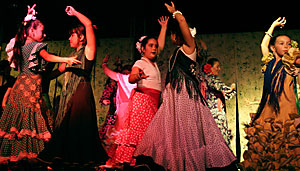 |
|
Djamila Grossman/Arizona Daily Wildcat
|
Dancers of the Club España de Tucson perform at the Tucson Meet Yourself folk life festival Friday. The festival drew people to El Presidio Park over the weekend and offered multicultural experiences in form of food, dance and music.
|
|
|
By Seth Mauzy
Arizona Daily Wildcat
Monday, October 10, 2005
Print this
Thousands of Tucsonans and UA students filled El Presidio Park downtown over the weekend for the 32nd annual Tucson Meet Yourself folk life festival.
The event offered three days of food, music, dancing and art from representatives of the many cultures that make their home in Tucson.
Numerous booths offered food and drinks from around the world; everything from Turkish coffee and Vietnamese egg rolls to homemade tortillas and Cuban chili.
Maribel Alverez, folklorist and UA English professor, has helped organize the event for the past two years. She also involves her English 248 Intro to Folklore class, requiring them to help organize and run a section of the festival as a requirement for the class.
Alvarez said that working at the festival gives her students an opportunity to understand and interact with various cultures that can not be replicated in the classroom.
"This is a hands-on, face-to-face experience with cultural diversity," Alvarez said. "Working the festival is like a folklore field school for the students."
This is an important element of an education in folklore, Alvarez said, because the subject is not one that can be easily explained in textbooks.
"Culture is a complicated element of people," Alvarez said. "It is hard to grasp the complexity of cultural works with theories and abstract ideas."
Students in Alvarez's class spent Saturday and Sunday helping set up and tear down the booths and tents, as well as assisting artisans and cooks in the folk arts, food and culture tents.
"I've been running around making sure the artists have everything they need," said Nick Michaud, a sophomore majoring in English. "We're also interviewing the folk artists to understand their art and culture as it pertains to the festival."
Students were also involved in recruiting people from the community to bring traditional dishes for the food and culture tent, a new addition to the festival that gave attendees a chance to sample foods from a variety of cultures under one tent.
Tijana "Tina" Skrepnik, a physiology freshman from Serbia, was invited by one of Alvarez's students to be the first to offer traditional Serbian food at the festival. She spent the weekend giving out samples and recipes for gibanica, a pastry made from Filo dough and three kinds of cheese.
"It is a 600-year-old traditional desert introduced to Serbia by the Turks. Americans seem to love it," said Skrepnik, adding that it was her favorite snack when she visited home. "I went through two pans and 60 recipes Saturday, so I brought more today and I still ran out."
After participating in the festival, Alvarez's students must integrate their experience into an essay reflecting on what they have learned. For students like Kyle Leahy, a creative writing senior, the fun of participating is more rewarding than a letter grade.
"This is a great learning experience. You're exposed to a lot of different cultures," Leahy said. "The people here will teach you how to make stuff. It's really entertaining, and the food's fantastic."
Alvarez's students were far from the only UA presence at the event.
The UA steel drum band entertained the crowd at the courthouse stage, and a number of campus cultural clubs contributed food, crafts and performances to the festival.
"This is my first year here, but the India Club has always helped out here since it started 10 years ago," said Sapna Patel, an astronomy and physics sophomore, while painting henna tattoos for donations to the club. "I didn't realize all the different cultures that were in Tucson. I love it."
Making the UA an integral part of the festival has been a conscious effort, made both by Alvarez and a change in management that sees the UA as an important facet in the gem of Tucson culture.
"The UA represents a culture of its own," said Bob Shatz, president of the Cultural Exchange Council of Tucson and co-organizer of the festival. "We are thrilled to see the youth come in and join the festivities. Those tents and that stage by the library wouldn't be here without the UA. We need their support."
